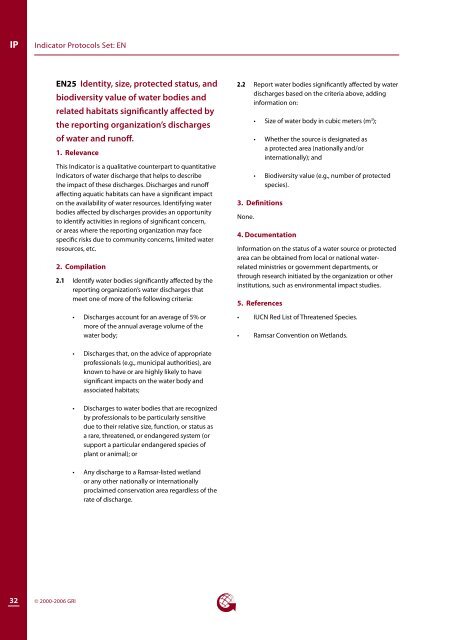Environment - Global Reporting Initiative
Environment - Global Reporting Initiative
Environment - Global Reporting Initiative
Create successful ePaper yourself
Turn your PDF publications into a flip-book with our unique Google optimized e-Paper software.
IP<br />
Indicator Protocols Set: EN<br />
EN25 Identity, size, protected status, and<br />
biodiversity value of water bodies and<br />
related habitats significantly affected by<br />
the reporting organization’s discharges<br />
of water and runoff.<br />
1. Relevance<br />
This Indicator is a qualitative counterpart to quantitative<br />
Indicators of water discharge that helps to describe<br />
the impact of these discharges. Discharges and runoff<br />
affecting aquatic habitats can have a significant impact<br />
on the availability of water resources. Identifying water<br />
bodies affected by discharges provides an opportunity<br />
to identify activities in regions of significant concern,<br />
or areas where the reporting organization may face<br />
specific risks due to community concerns, limited water<br />
resources, etc.<br />
2. Compilation<br />
2.1 Identify water bodies significantly affected by the<br />
reporting organization’s water discharges that<br />
meet one of more of the following criteria:<br />
• Discharges account for an average of 5% or<br />
more of the annual average volume of the<br />
water body;<br />
2.2 Report water bodies significantly affected by water<br />
discharges based on the criteria above, adding<br />
information on:<br />
• Size of water body in cubic meters (m 3 );<br />
• Whether the source is designated as<br />
a protected area (nationally and/or<br />
internationally); and<br />
• Biodiversity value (e.g., number of protected<br />
species).<br />
3. Definitions<br />
None.<br />
4. Documentation<br />
Information on the status of a water source or protected<br />
area can be obtained from local or national waterrelated<br />
ministries or government departments, or<br />
through research initiated by the organization or other<br />
institutions, such as environmental impact studies.<br />
5. References<br />
• IUCN Red List of Threatened Species.<br />
• Ramsar Convention on Wetlands.<br />
• Discharges that, on the advice of appropriate<br />
professionals (e.g., municipal authorities), are<br />
known to have or are highly likely to have<br />
significant impacts on the water body and<br />
associated habitats;<br />
• Discharges to water bodies that are recognized<br />
by professionals to be particularly sensitive<br />
due to their relative size, function, or status as<br />
a rare, threatened, or endangered system (or<br />
support a particular endangered species of<br />
plant or animal); or<br />
• Any discharge to a Ramsar-listed wetland<br />
or any other nationally or internationally<br />
proclaimed conservation area regardless of the<br />
rate of discharge.<br />
32<br />
© 2000-2006 GRI

















